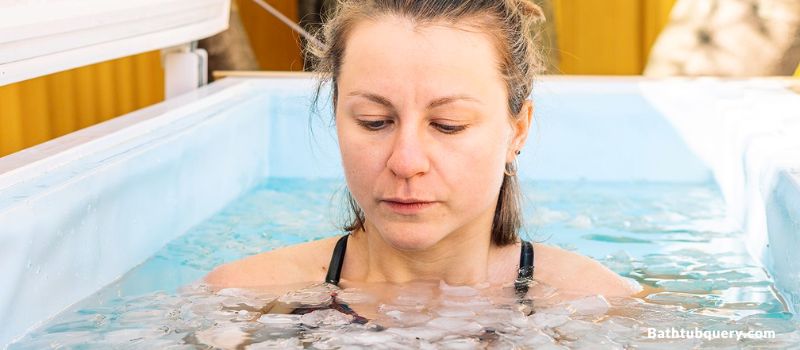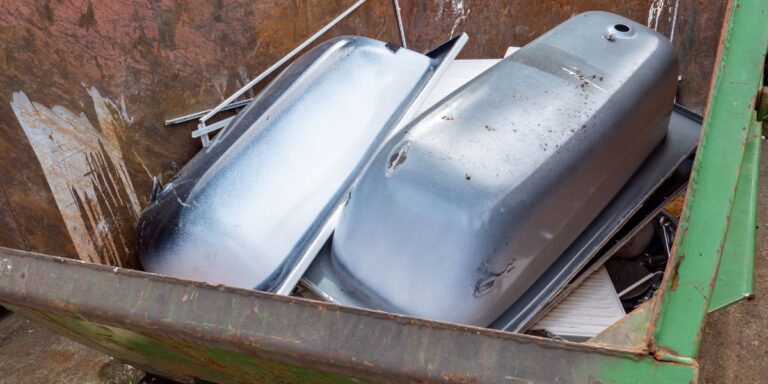Can You Do An Ice Bath In A Bathtub?
An ice bath may sound like an extreme therapy, but soaking in a tub filled with ice cold water actually provides some real health benefits. The practice has been around for centuries, used by athletes and health gurus alike to help reduce inflammation, improve circulation, and even just energize both the mind and body.
The idea of an ice bath is based on the concept of cold thermogenesis – using cold exposure to activate the sympathetic nervous system and constrict blood vessels. This forces blood from the extremities to your core organs and then when you get out of the bath, fresh new blood flows back into the extremities. Kind of like a reset button for your circulatory system!
While an ice bath may sound intense, you can absolutely create this experience right at home using your own bathtub and some ice. With some preparation and safety precautions, an ice bath can become part of your regular wellness routine. Keep reading to learn all about the unique health benefits of ice baths, how to set one up on your own, and tips to make it as safe (and tolerable!) as possible.
Can You Do An Ice Bath In A Bathtub?
Yes you can take. bath in a bathtub. Here are the surprising benefits of ice baths. I know it sounds counterintuitive to soak in ice water for health, but cold therapy like ice baths actually provides some legit benefits for both body and mind. Here are some of the major perks:
| Benefit | Explanation |
|---|---|
| Muscle Recovery | Ice baths can help reduce inflammation and speed up recovery after workouts. |
| Improved Circulation | The cold water can help flush out toxins and bring fresh, oxygenated blood to your muscles. |
| Boost Mood | Ice baths may help stimulate endorphin production, leading to mood enhancement. |
Improved Circulation and Cardiovascular Function
Like mentioned earlier, the cold causes your blood vessels to constrict, forcing blood back to your organs and out of your extremities. This helps reset your circulatory system, and when you get out of the ice bath, new oxygenated blood will flow back out to your muscles and skin. Over time, this process can help strengthen your blood vessels and heart.
Some research has found that regular cold exposure, like ice baths, can help lower blood pressure and reduce the risk of heart disease. The cold also helps improve vein health and may help minimize varicose veins.
Reduced Inflammation and Muscle Soreness
The cold temperatures of an ice bath have been shown to help reduce inflammation throughout the body. This is why ice baths are often used by athletes as a way to speed up recovery from intense workouts or sports matches.
The cold can essentially numb any pain from sore muscles or injuries. It also constricts blood vessels around damaged muscle fibers, limiting circulation to reduce swelling and inflammation. Ice baths may help you bounce back faster after tough workouts.
Increased Energy and Alertness
An ice bath actually stimulates the release of endorphins – those feel-good chemicals in the brain that give you a sense of mental clarity and alertness. The rapid cooling from the cold temperatures also activates the sympathetic nervous system, making you feel energized and even euphoric.
Some people use ice baths first thing in the morning to feel ready to take on the day. The cold shock essentially jolts your mind and body awake.
How Does Such Cold Water Provide These Benefits?
I know it can seem counterintuitive that literally freezing your body could actually be good for you! Here’s a look at what’s happening on a physiological level:
- The cold temperatures cause your blood vessels to rapidly constrict to send blood to your core. This helps reset your circulatory system.
- When you get out of the bath, your blood vessels dilate, and fresh new blood circulates to your muscles and skin.
- The cold exposure releases anti-inflammatory cytokines to reduce swelling and pain.
- It activates the sympathetic nervous system, giving you an energizing “fight or flight” response.
- Endorphins are released, which improve your mood and give you a euphoric feeling.
Basically, the rapid cooling and warming shock your system in a good way!
Tips For An Ideal At-Home Ice Bath Experience
To make your ice bath as pleasant as possible, given the freezing cold water, follow these tips:
- Start with cool water first rather than immediately freezing – This allows your body to slowly adjust to the decreasing temperatures.
- Only stay in the ice bath for 5-15 minutes max – This prevents hypothermia. Know your limits and get out if you start shivering violently.
- Keep towels or a robe and warm clothes nearby – Quickly dry off and change into warm clothes after your ice bath to allow your body to gently rewarm.
- Take slow deep breaths and remain calm – Your instinct will be to panic, but focus on your breathing and relaxing your muscles. Don’t tense up.
- Consider wearing socks – Since your feet and hands get cold the fastest, socks can make ice baths a bit more tolerable.
- Use treats as motivation – Promise yourself hot cocoa or a relaxing activity after your ice bath to stay motivated.
With practice, you can learn to relax and almost enjoy your at-home ice baths! Just ease into it slowly at first.
Ice Baths Can Be Invigorating
I know that soaking in a tub of ice seems insane. But once you get past the shock, ice baths can actually be energizing and almost euphoric. Starting your day with an ice bath may sound scary, but it can leave you feeling ready to take on anything.
Ice baths don’t have to be intimidating. Start conservatively, be smart, and work your way up as your body adapts. And focus on all the health perks you’re giving your circulation, inflammation levels, energy, and more. Just taking five minutes to reset your body with cold therapy can have a big impact.
So consider keeping a bag of ice on hand for when you need a physical and mental pick-me-up or just want to relax in an unconventional way! With the right preparation, you can absolutely reap the benefits of ice baths safely in your own bathtub. Give it a try and see how this strange wellness practice leaves you feeling surprisingly rejuvenated.
How to Take an Ice Bath Without a Bathtub?
The easiest way to take an ice bath is in a bathtub filled with cold water and ice. However, if you don’t have a bathtub, there are a few other options:
Use a large plastic tub or bin:
Look for a tub or bin that is big enough for you to sit in with your legs extended. Fill it with cold water and add ice. This allows you to immerse your whole lower body.
Take a cold shower:
Turn your shower to the coldest setting and stand under the water for a few minutes. This exposes the whole body to cold water but isn’t quite as extreme as full immersion.
Use an ice vest or towels:
Wear an ice vest packed with ice cubes or wrap ice packs or freezing cold wet towels around your torso and limbs. This is more of a partial ice bath, focusing on core body temperature.
Sit in a cold kiddie pool:
Fill a plastic kiddie pool with cold water and ice and sit in it, immersing your lower half. A larger size pool will allow more complete immersion.
Jump in a cold lake or river:
Finding a very cold natural body of water like a lake or river can simulate an ice bath. This is dependent on your location and time of year.
The tub method is the most effective for full body exposure to cold temperatures. But the other options let you get creative and make ice baths work in any setting!
How Many Ice Baths Per Week?

There is no universally standard frequency for ice baths. How often you should take ice baths depends on your goals, tolerance, and overall health. Here are some general guidelines:
- For recovery after intense training, aim for 2-4 ice baths per week. Spread them out with at least a day in between.
- For general health benefits, 1-2 weekly ice baths is likely sufficient. Listen to your body.
- Start with only 1-2 sessions per week when first beginning. Gradually increase frequency if you tolerate it well.
- Avoid ice baths 2 days before or after an intense competition. The stress may inhibit recovery.
- Take a break if you feel overly fatigued, your immune system is compromised, or you have any injuries.
The ideal frequency for you also depends on the temperature and duration of your ice baths. Colder water and longer sessions of 10+ minutes provide a stronger stimulus. In these cases, limit to 2-3 baths per week to allow adequate rest and recovery in between.
Pay attention to your energy levels, sleep quality, and soreness when gauging the right ice bath routine for you. Start conservatively and increase frequency slowly over time. Consistency over the long-term is key.
How to Take an Ice Bath Without Pain?
Ice baths literally involve submerging into freezing cold water, so they can naturally be uncomfortable. Here are some tips to make the experience more tolerable and less painful:
- Acclimate slowly – Ease into the cold water inch by inch instead of plunging right in. This allows your body to adjust gradually. You can also try rapidly alternating dunking different body parts.
- Breathe deeply – Deep rhythmic breathing helps shift your focus and promotes relaxation. Exhale as you lower into the water.
- Use meditation or distraction – Listen to music, do a mental meditation, or engage in conversation to take your mind off the cold.
- Move around – Gentle movement can take your mind off the cold sensation and generate some heat. Slowly move your legs and arms without lifting out of the water.
- Wear thick socks – Keeping your feet warm and insulated with wool socks helps reduce discomfort. Thick gloves can also help for your hands.
- Take it in short bouts – You don’t need to stay submerged for the whole time. Do cycles of immersion for 30-90 seconds followed by briefly standing up.
- Use warmer water – Start with the water near 60 degrees F rather than fully icy and work your way colder over time as you adapt.
With practice, your tolerance will improve. But don’t force yourself to stay in if the pain is intolerable. Listen to your body and adjust the temperature and duration appropriately.
How to Take an Ice Bath Without Ice?
While ice baths do contain ice, you can simulate the cold temperature without needing actual frozen cubes. Some ice-free alternatives include:
- Fill your tub with only cold tap water – Water straight from your cold tap can reach temps cold enough to provide benefits. Shoot for around 50-60°F.
- Add salt to very cold water – The salt lowers the freezing temp, making the water feel colder without diluting it like ice would. Use 2-6 cups of salt per bath.
- Use reusable cold packs – Keep several cold packs in your freezer and rotate them into your cold water to maintain low temps. Re-freeze after each use.
- Take a cold shower – With a shower, you don’t need ice. Just use the coldest possible water temperature.
- Submerge limbs – You can get some effects by just immerging your hands, feet, or arms in very cold water without ice.
While ice enhances the intensity, these ice-free methods can still provide benefits, especially if you are new to cold exposure. Focus more on the temperature of the water than needing actual frozen ice. Work your way down to colder temps over time.
What to Do After an Ice Bath?
To maximize benefits and recovery, it’s important to follow good post-ice bath practices:
- Dry off – Have towels ready and thoroughly dry yourself immediately after getting out. Put on warm, dry clothes right away as well.
- Keep moving – Do light activity like walking around your house or slow yoga poses. This helps circulate blood flow.
- Have a hot drink – Sip on something warm like tea, bone broth, or ginger tea to gently raise your core body temperature.
- Take it easy – Avoid intense activity and give your body time to recover. The stimulation of the ice bath puts stress on your nervous system.
- Be patient for benefits – It takes time for metabolic and circulatory changes to occur after cold exposure. Don’t expect instant results.
- Watch for side effects – Monitor for excessive fatigue, sore muscles, or other concerning symptoms that may indicate overtraining.
- Get warm slowly – Dramatic reheating too quickly after an ice bath can be counterproductive. Allow your body to gradually return to homeostasis.
Proper rest and recovery after an ice bath allows your body to reap the rewards. Be sure not to rush into stressful training too soon afterwards.
Are Ice Baths Dangerous? Safety Tips
Despite potential benefits, ice baths do come with some precautions:
- Avoid ice baths if you have any cardiovascular conditions without medical clearance. The cold stress on your heart and vessels can be dangerous.
- Be cautious with Raynaud’s disease which affects circulation. The extreme cold can restrict blood flow to the limbs.
- Don’t ice bathe if you are sick or immunocompromised. The cold exposure may overwhelm your already taxed system.
- Start very conservatively if you have high blood pressure. Discuss with your doctor before progressing.
- Limit to 5-15 minutes initially before building up duration to avoid overstressing your body.
- Check with your doctor if taking cold-sensitive medications like beta blockers. Timing of medication related to ice baths may need adjustment.
- Avoid full body exposure if you struggle with anxiety, panic attacks, or have claustrophobia issues.
- Never ice bathe alone – Always have someone with you in case of an emergency.
- Stop immediately if you feel lightheaded, confused, weak, or shivering uncontrollably. These are signs of hypothermia.
With proper precautions, most people can tolerate ice baths well. But certain populations should exercise more caution. Always consult your doctor before beginning. Start gradually and listen carefully to your body.
Key Takeaways
Ice baths in a bathtub are not just feasible, but they also offer several potential benefits. Just remember to follow safety guidelines to have a beneficial and comfortable ice bath experience at home.
FAQs
How long should I stay in an ice bath?
Generally, it’s recommended to stay in an ice bath for 10-20 minutes.
How cold should an ice bath be?
Ideally, the water temperature for an ice bath should be between 50-59°F (10-15°C).
Is it safe to take an ice bath every day?
Yes, but always listen to your body. If you’re feeling discomfort, it’s better to give your body a rest.
Can ice baths help with weight loss?
There is some evidence to suggest that cold exposure can increase calorie burn, but it should not replace a balanced diet and regular exercise.
Can people with health conditions take ice baths?
People with certain health conditions like cardiovascular disease should avoid ice baths. Always consult your doctor before starting new health practices.
Related articles:
- Can I Wear A Tampon In The Bathtub?
- Can You Get Electrocuted in the Bathtub?
- Can Epsom Salt Damage Your Bathtub?
- Do I Need A Baby Bathtub?
- How To Turn A Bathtub Into A Planter?

William J. Bullock is a licensed plumber with over 15 years of experience installing and repairing bathtubs. He runs his own plumbing company in Greenville and serves residential and commercial clients. William is dedicated to providing honest, transparent advice to help homeowners make informed decisions about their bathroom renovations.
He has established expertise in selecting bathtubs, planning custom installations, diagnosing issues, and completing repairs. William aims to share practical tips and reliable recommendations based on extensive hands-on work. When he isn’t on a job site, William enjoys spending time with his family and volunteering at local community events. He takes pride in delivering quality service and enjoys helping people upgrade their homes.







